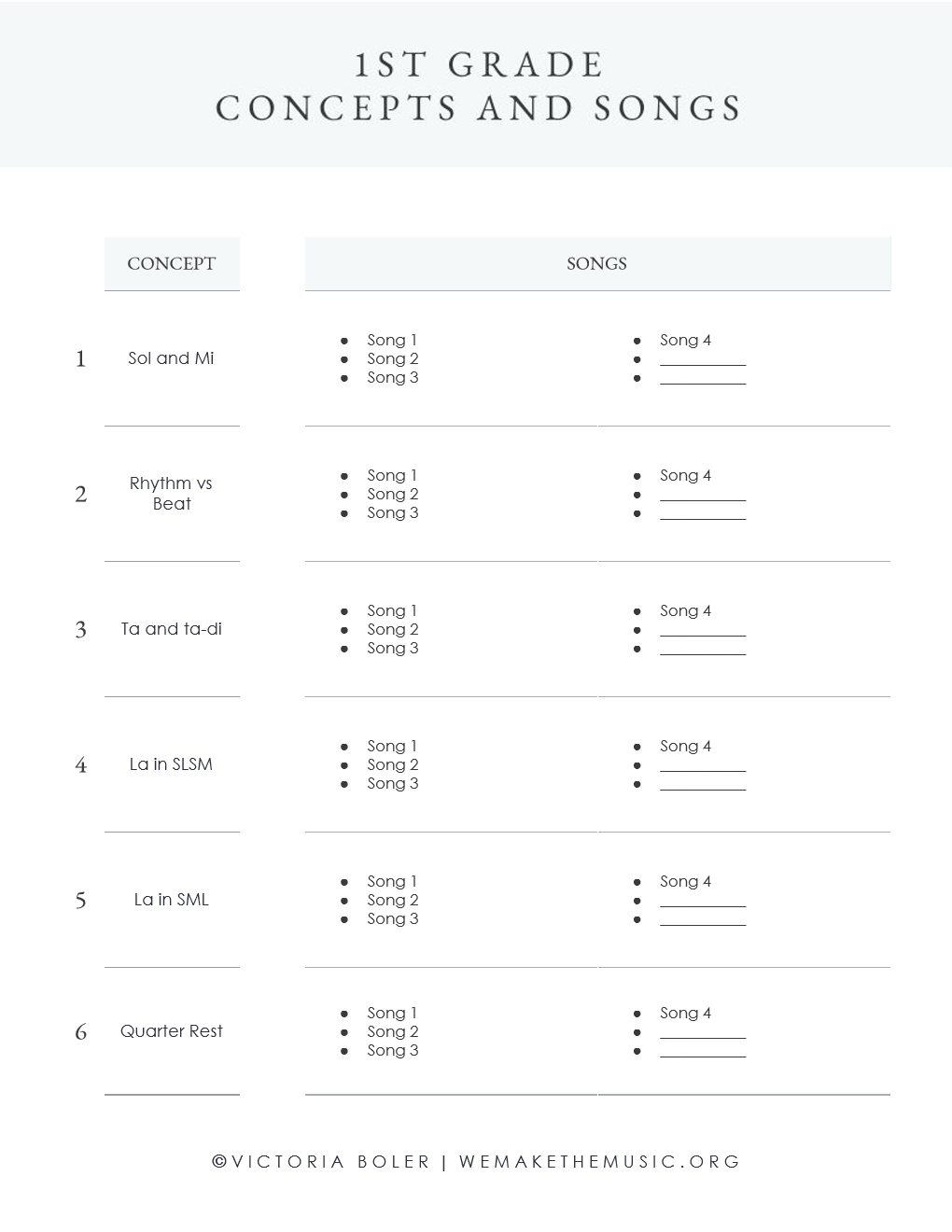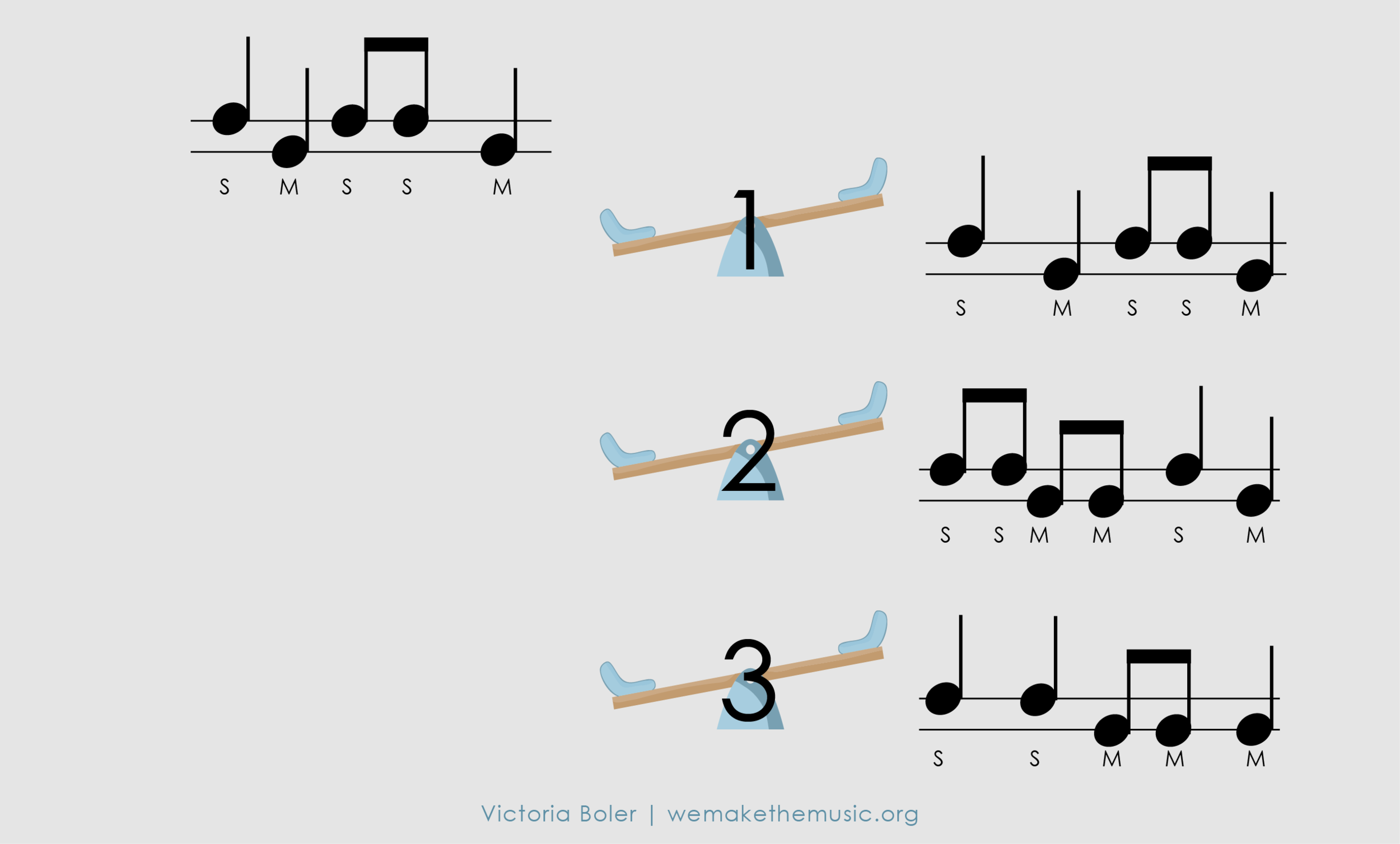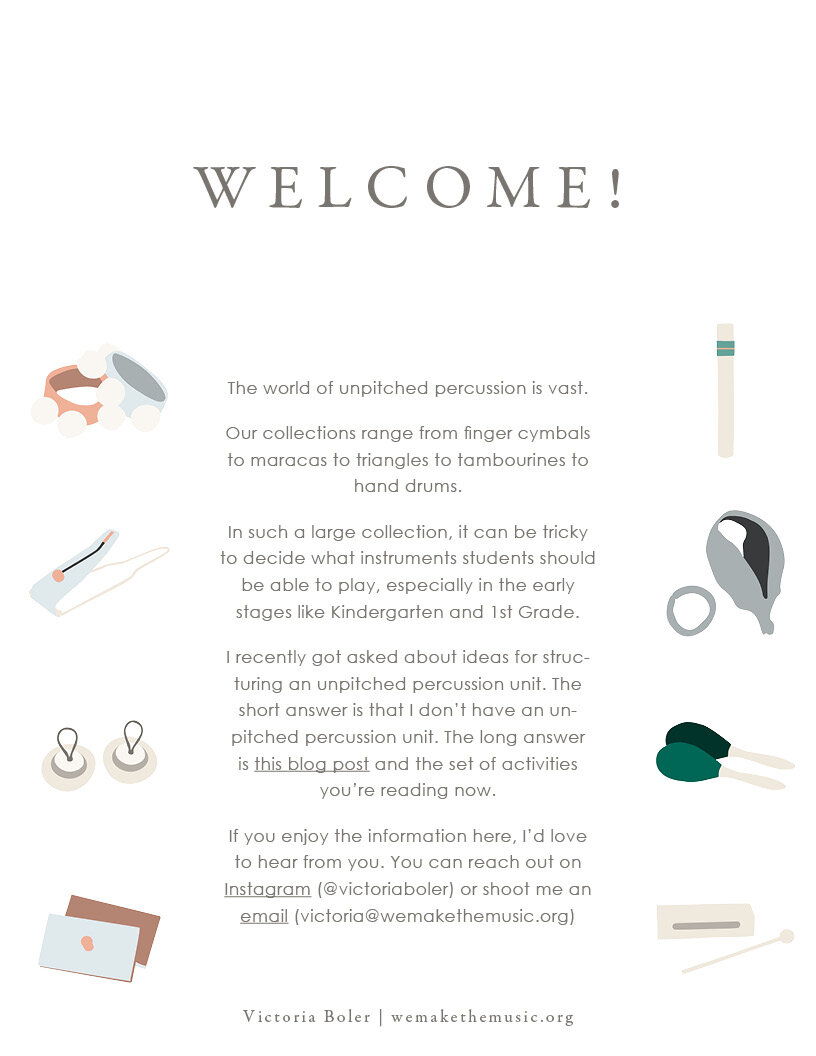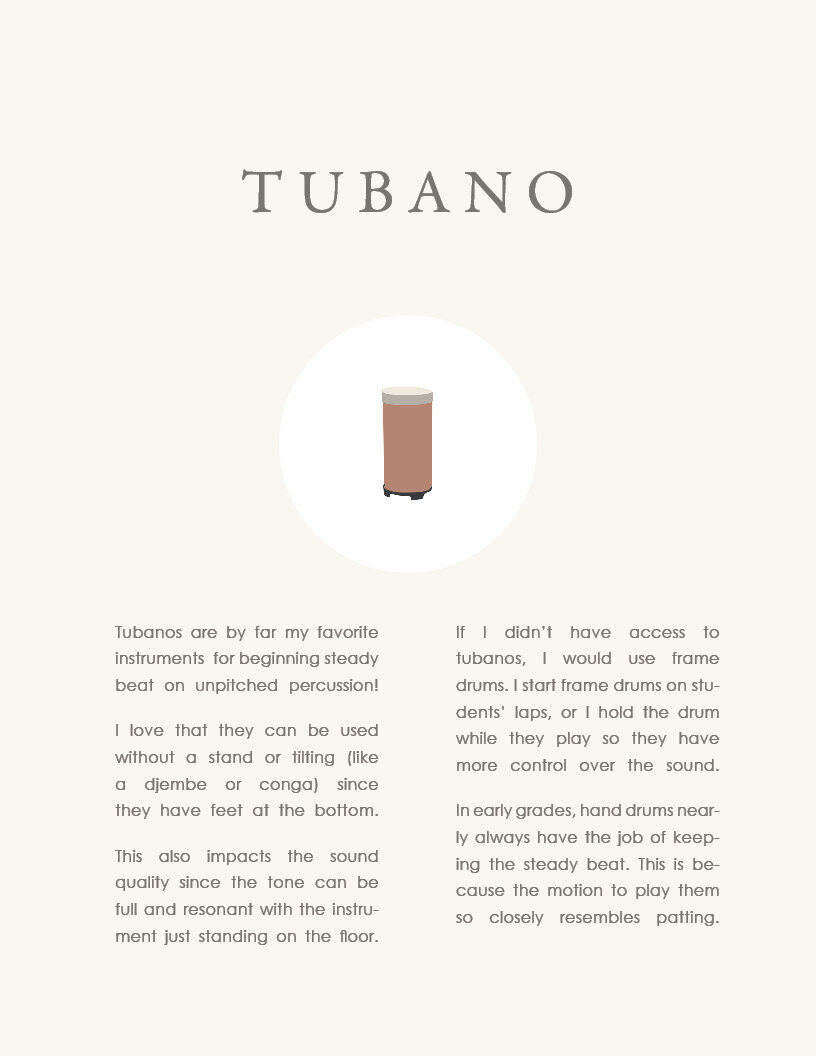This lesson plan is based off the 1st Grade February monthly plan in The Planning Binder. You can also grab a free PDF version of this lesson at the bottom of the post.
Let’s jump in!
Zooming Out - The Big Picture
Previous Knowledge
When students walk into this lesson, they already have experience singing, playing, reading, writing, aurally identifying, improvising, and arranging the following concepts:
High and low
Sol and mi
La
Steady beat
Rhythm vs beat
Ta and ta-di
The Planning Binder walks through strategies to teach each of these previous concepts in the 1st Grade concept plans.
Long-Term Plans
A scope and sequence helps track what students have learned, and when they learn it.
The scope and sequence below is a small portion of the one in The Planning Binder. This is lesson #18 (look at column B to see the lesson numbers). By this point in the curriculum, students are preparing quarter rest for the third time (column C), and are practicing sol and mi for the fifth time (column D).
Song Materials:
The song materials in this lesson come from my concepts and song lists I make at the beginning of each year. This document specifies most of the songs I’ll use to work with each specific musical concept.
Typically, I use somewhere between four and six songs per concept. Before the year begins, I map out the first four, and leave space to be inspired throughout the year.
This image shows an example of the concepts and songs layout. You can find this filled in document in The Planning Binder.
Having the first four songs in place means that I’m never searching for song materials the night before a lesson. Things are in place in a purposeful, yet flexible, outline.
Here are the materials for this lesson:
Acka Backa
Bow Wow Wow
Doggie Doggie
Jack and Jill
I See the Moon
Rig a Jig Jig
Seesaw
The Lesson Plan
Warm Up Routine: 4 minutes
Active music time begins the very moment students show up for class. The teacher greets students at the door, leads the whole class in marching to a steady beat, and eventually the class ends up in a circle.
This lesson, students walk in to My Girl, performed by The Temptations. When they’re in a circle, students follow the teacher for the steady beat motions. At some point, different students take turns leading the class through other movement ideas.
Sing Greetings:
The melodic focus of the lesson is sol and mi, so that is included in our warm up routine. The teacher sings a greeting on sol and mi, and the class improvises answers. Listen to a few students improvise as an assessment if there is time.
Students often get a chance to perform individually in our warm up routine. I may listen to five to seven students per warm up activity (including melody and rhythm). I record their response as an assessment. Over the course of the whole year, this gives me an idea of how students are progressing through fundamental pitch and rhythm skills.
Rhythm Patterns:
The next item in the warm up routine is clapping patterns or body percussion patterns. The rhythmic focus of this a beat of silence, so the rhythm patterns will include that as well.
Since this is the lesson right before presenting standard notation for quarter rest, students will also have the option to copy the teacher’s pattern or improvise their own pattern.
The teacher claps a few patterns and motion for students to copy. Then, the teacher invites students to make up their own response to the pattern. Just like in the melodic sequence, a few students may share their ideas individually for an assessment.
The warm up sequence takes a long time to explain, but a short time to implement! This whole sequence takes about four minutes. You can read more about my warm up sequence here.
Transition: The teacher claps the rhythm of Acka Backa while students step to their spots in a steady beat.
Main Activities:
Acka Backa: 4 minutes
In their spots, students sing and point to steady beat hearts on the board.
Then, students clap the rhythm of the words while the teacher points to the steady beat hearts on the board. Students help dictate the rhythm of the song above the steady beat hearts.
Leave the beat without a sound blank.
Play the game!
Transition: The teacher claps the rhythm of I See the Moon. Students listen to whether or not the rhythm has a beat of silence in it, and give a thumbs up or thumbs down.
I See the Moon: 8 minutes
Students move in open space (spin like a planet, float in gravity, shimmer like a star, etc.) while singing the song.
Then, half the class moves to barred instruments while singing the song.
They make up a B section by improvising the rhythm of the song on any pitches in the pentatonic scale. As they improvise, the rest of the class moves in open space. Students switch jobs, so each half of the class has a chance to play instruments.
Transition: Students move to their spots. As they move, they sing I See the Moon and the teacher sings Bow Wow Wow.
Bow Wow Wow: 8 minutes
Students sing the song and play the game.
In a previous lesson, students came up with a physical silent motion to represent a beat of silence. Students sing the song using their chosen motion from last class.
Then the teacher asks, “How could you write your motion for a beat of silence so a friend could read it?”
Students help the teacher write the song in traditional notation on the board.
Using whiteboards, ipads, or paper and pencil, students copy the notation from the board and write their own ideas for a beat of silence.
A few students share their ideas on the board.
Teacher Talk: Sequencing
In the next lesson, students will learn the “real” name for a beat of silence. This activity gives me a sense of whether or not the class as a whole is ready for that next step.
Transition: The teacher sings directions to put writing materials away to the tune of Rig a Jig Jig.
Rig a Jig Jig: 3 minutes
After sitting down for a notation activity, it’s time to move again! This song is just for fun.
Transition: The teacher sings the melody to Seesaw on a neutral syllable. Students echo sing as they move back to their spots.
Seesaw: 4 minutes
Sing and move to sol and mi. Then, sing and create high and low movements with a partner.
Seated, the teacher sings the first half, and students read each response from the board.
Then, students sing the first half and the teacher sings the response. Students show on their fingers which response the teacher sang.
Next, the teacher sings the first half and students sing any response they want.
Then, students choose one partner to sing the first half and one partner to sing the second half. They’ll switch jobs so everyone has a turn.
Teacher Talk: Practice and Assessment
This is the third time in The Planning Binder monthly plans that students have done this activity, so I feel comfortable taking individual student responses as an assessment. As students work with their partner, I walk around and listen to groups perform.)
Transition: The teacher changes the melody on the board to the opening of Jack and Jill. Students read using solfege syllables and hand signs.
Jack and Jill: 4 minutes
Students sing the song in their heads while acting out the story with a partner.
As they act out the story, the teacher writes the rest of the melody on the board but leaves a few pitches out.
With their partner, students figure out which beat is missing, and which pitch should live there. A few students come up to the board to fill in the missing pitches in standardized notation.
Students sing again on solfege while moving up and down with their partner.
Transition: The teacher changes the notation to the first four beats of “Doggie Doggie.” Students sing on solfege and guess the song from three options on the board.
Doggie Doggie: 5 minutes
Students sing the song as they move to barred instruments.
Two partners sit behind each barred instrument. Both partners sing the song. Then, one sings, “Who stole my bone?” and the other plays an improvised answer using sol and mi.
Students switch so each partner gets a turn.
Transition: The teacher says, “I loved hearing all your improvisations! Let’s listen to two other people improvise. Their names are Ella Fitzgerald and Duke Ellington. Be ready to share something you noticed about the video with a partner”
Closing:5 minutes
Students move back to their spots while the song plays.
After the video, the teacher sings the book, This Jazz Man as students act out the instruments from their spots.
When it’s time to line up, the teacher continues singing the book as students move to the line.
When students are standing in line, they turn to a partner and share something they noticed about the video of Ella Fitzgerald and Duke Ellington.
Lesson Plan PDF
Click the images below to download this lesson as a PDF.
If you use any of the ideas in this lesson, I’d love to hear from you. You can find me on instagram (@victoriaboler), shoot me an email (victoria@wemakethemusic.org), or drop a comment below.



























